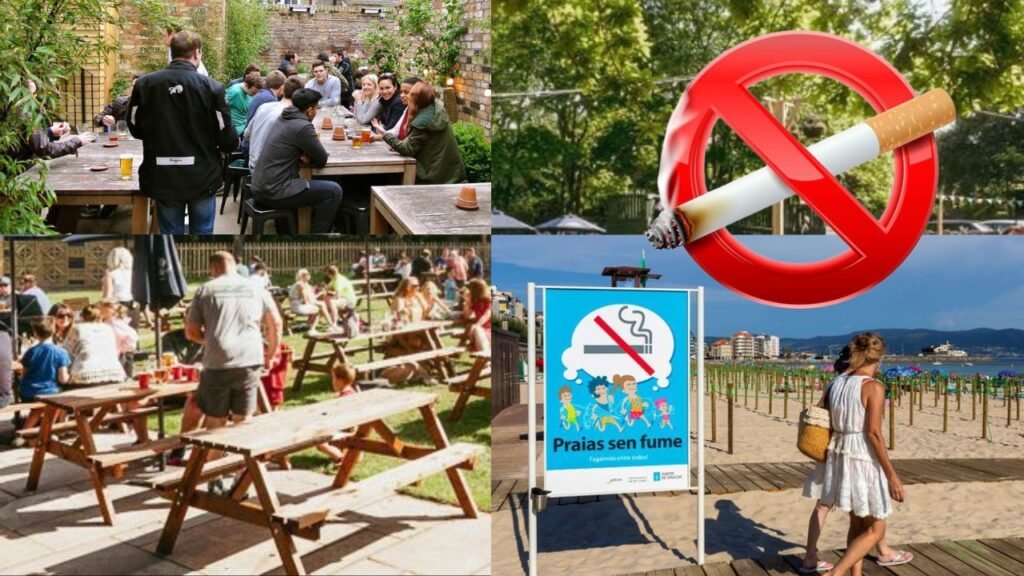A Significant Policy Change
Leaked Whitehall documents show that the UK government is planning to implement a broad ban on smoking in outdoor public locations, which is a revolutionary step. The main objective of this project, which is a bold extension of the current indoor smoking prohibition, is to improve public health by lowering secondhand smoke exposure. The new regulations are set to cover a wide variety of outdoor spaces that are frequently used for socialising and gathering, including restaurant patios, bar gardens, and even the grounds outside of sports stadiums.
What’s Covered Under the New Ban?
The new restrictions cover a wide range. According to the documents that were leaked, smoking would not be allowed in the following areas:
- Restaurant seating areas and pub gardens: Smoking is prohibited in these well-liked public areas where customers frequently enjoy food and beverages outside.
- Outside Club and Cafe Spaces: The new regulations will apply to any outside seating spaces connected to clubs and cafes.
- Pavements Beside Dining Establishments: To prevent smoke from drifting into dining areas, the prohibition will also apply to pavements beside bars and restaurants.
- University Campuses, Hospitals, and Sports Grounds: For the safety of both students and guests, smoking is not permitted on the property of universities, hospitals, or sports venues.
- Children’s Playgrounds and Small Parks: To protect children from secondhand smoke, areas where children play, as well as smaller parks, will be covered.
These new regulations will probably make it harder for shisha bars to stay open. Big open areas like parks and streets, as well as private residences, will not be subject to the prohibition. The government is currently considering if the ban should apply to enclosed parks with large populations and beaches.
Effects for the Economy and Society
A lot of discussion has been created by the thought of prohibition among companies and politicians. The Department has expressed concerns on the possible economic impact, highlighting concerns that the ban may result in large-scale company closures and loss of employment in the hotel industry. The government observed the large investments companies made in outdoor areas following the indoor smoking ban in 2007, but warned that additional rules might have a detrimental effect on these businesses.
Despite their objections, England’s Chief Medical Officer, Professor Chris Whitty, and Prime Minister Rishi Sunak have gone ahead with the proposal. They argue that reducing smoking-related health care costs will result in long-term economic benefits that far exceed the short-term financial losses. The anticipated yearly health care expenses associated with smoking are £21.8 billion, a sum that far exceeds the money collected from tobacco taxes.
Building on Previous Achievements
The success of the 2007 indoor smoking ban—which, despite initial concerns, did not negatively impact companies but rather resulted in notable benefits to public health—is being built upon by this new program. Expanding smoke-free areas to outdoor public areas is the current goal in an attempt to duplicate this accomplishment.
The National Health Service (NHS) has long issued warnings on the dangers of passive smoking, particularly for young people who are more at risk for respiratory illnesses and asthma. The primary objective is to promote healthier public areas and help achieve the bold target of having under 5% of the population smoke in England by 2030, or “smoke-free.”
Public Opinion and Political Reactions
There is controversy in politics over the proposed ban on smoking outdoors. It is anticipated that the Sir Keir Starmer led Labour Party would back the ban even though it was not included in their pre-election manifesto. Opposition says that voters should have been informed of such important policy changes before the election. The government’s approach is expected to come under intense review from the opposition, especially given that no public engagement took place previously to the policy details being released.
Official public consultation is planned, although rumors among insiders indicate that the main ideas won’t likely change. The purpose of the consultation is to find out what the general public thinks about particular aspects of the ban, such as the exact distance from designated locations where smoking is prohibited.
Addressing Problems
There are still several unclear areas in the suggested plan. For instance, there is ongoing discussion on how to manage areas like beaches and smaller, enclosed parks. To guarantee that the prohibition is both possible and successful, one possible tactic is to make a distinction between larger, open places and smaller, highly packed ones.
There is also continuous discussion about whether vaping supplies and e-cigarettes will be prohibited. Although the original plan concentrates on conventional tobacco products, there is still controversy surrounding vaping, which might have an impact on both the vaping sector and its customers.
Bold Public Health Plan
Proposing an outdoor smoking ban indicates a strong commitment to reducing the harmful effects of smoking on children and nonsmokers alike, which is a huge step forward for public health policy. The initiative’s primary objectives are to improve public health and lessen the financial burden of smoking-related disorders on the National Health Service (NHS). Opposition is anticipated from several economic sectors, including the hotel industry and influential politicians.
As this strategy moves forward, the government will have to make sure that the new restrictions are applied equally and effectively while also carefully balancing public health goals with economic effects. This initiative’s success might establish a new standard for such actions globally, representing a major advancement in the global battle against smoking’s harmful effects on one’s health.









